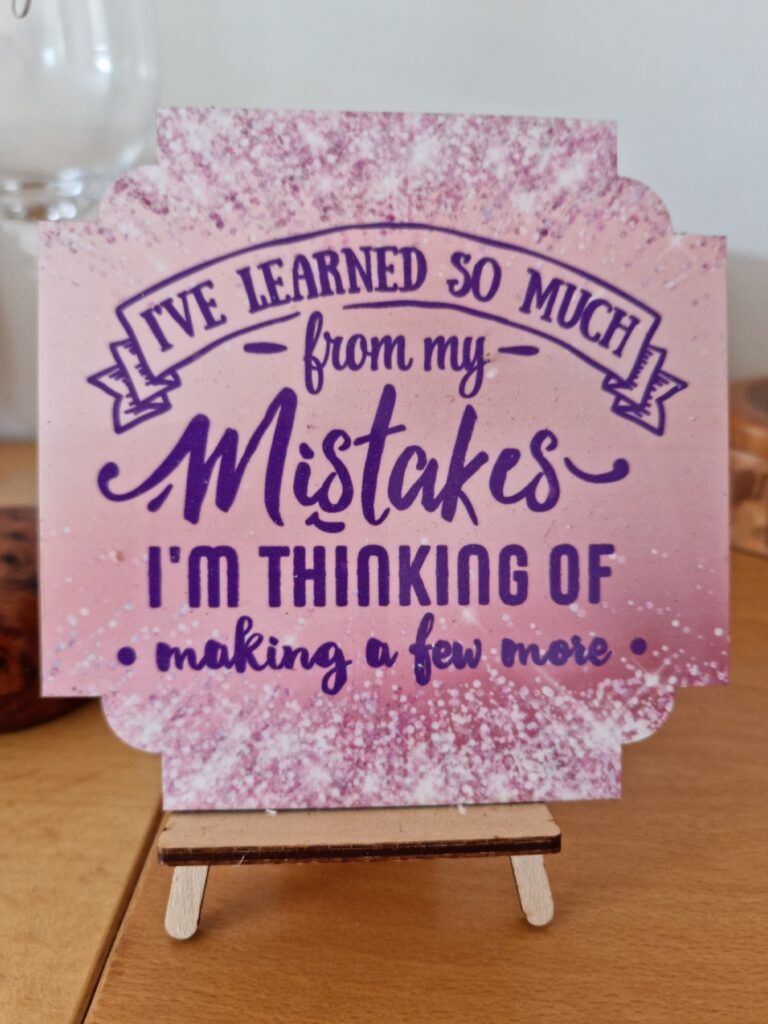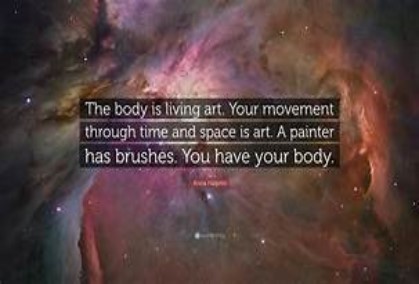
At this late stage (November 2023) in the development of my website, I write the next paragraph to summarise my main message to date.
Therapy and small, safe experiments can help me connect the ‘dots’ making up my life through taking action. You, too, can choose to implement such action. You, alone, can just notice (or not) the results created by your small, safe experiments. You live with consequences and you can design a next step or let it just happen. You can build on small victories and face small defeats by doing something just a little bit different next time.
Here is a very personal example of making such connections using this website. It may appear self-indulgent to some people but I still offer it so you might seek out your own connections, perhaps with the help of this website.
A personal example
I had a recent experience of connection when, like you, I was resisting change. In a dream, contents now long gone, I was able to review how I am going about retiring from my working career – one that has occupied much of my time and emotional energy.
I was able to re-evaluate this process by seeing connections between:
* Erik Erikson’s material on life changes.
……. and parts of Eric Berne’s Transactional Analytic (TA) model.
….. and just noticing where I think I am on my journey through life. This required some attention to the lies I have told myself and how those safe experiments have faltered from time to time. That’s three connections in one small paragraph!
As a result, I have re-positioned myself on that scenic route.
My example may help you make your own connections using this website. Here it is:
Erik Erikson’s on Human Growth and Development
Let’s look at it. The relevant illustration from Erikson, included on this website is:
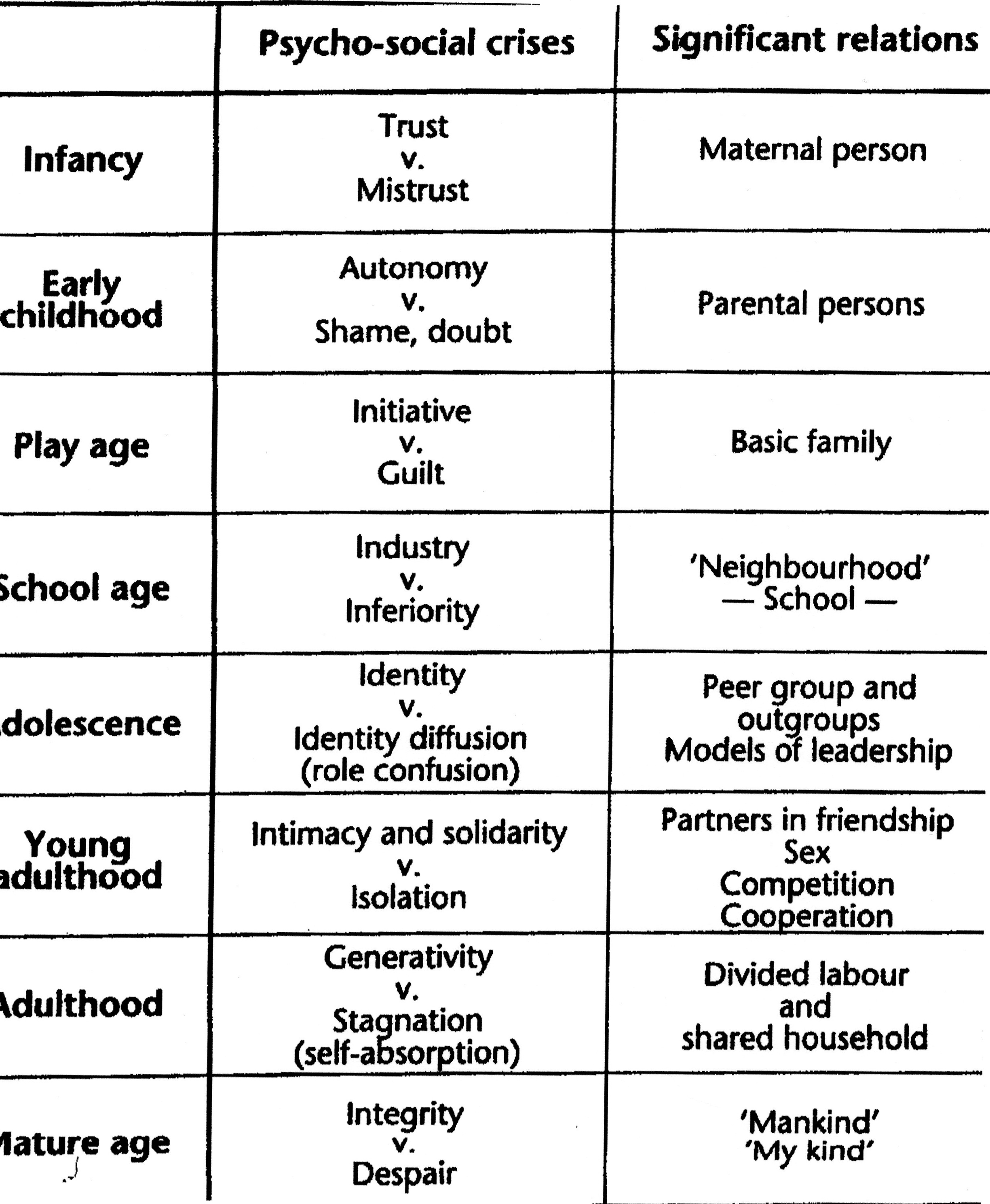
…. with particular reference to those last two stages – Adulthood and Mature age. Anyone who has retired, or thought about it, may been troubled by the prospect of ‘stagnation’ and the despair that can come with it.
Transactional Analysis (TA) on ‘Life Positions’
One connection I made with Erikson’s model in mind was to TA Life Positions. Here is one way to present them:
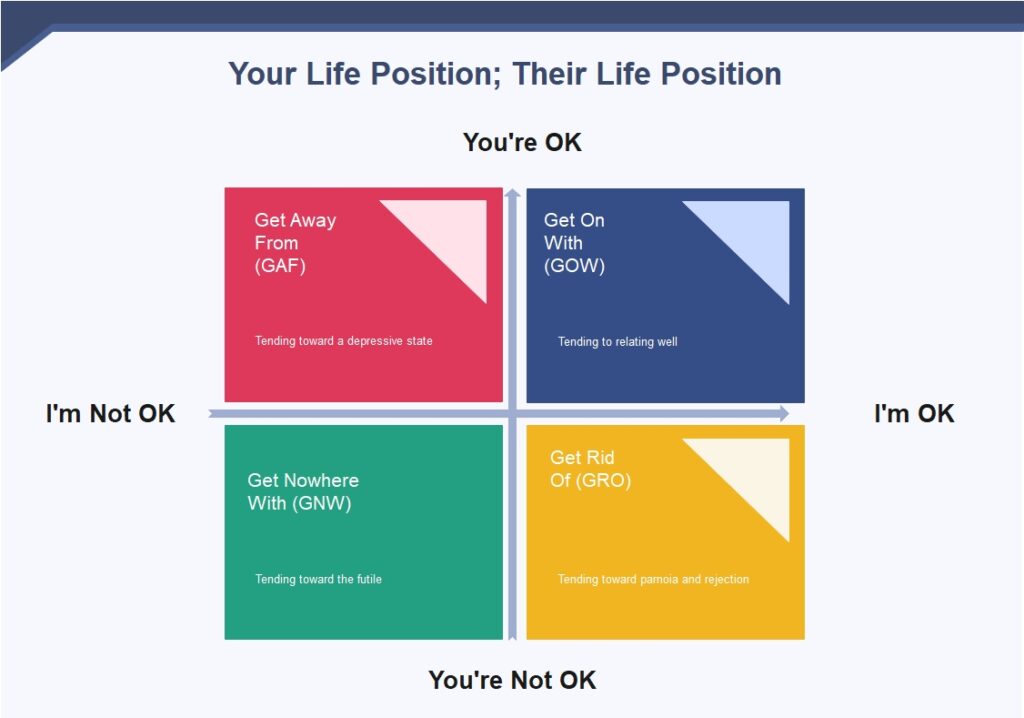
… where my own ‘life position’ is on the line going from left to right – and my view of other people is located on the line going up and down. The ‘ideal’ would be to occupy the upper right box most of the time. Here “I am OK and You are OK” and I can get on with (GOW) most people, most of the time. In actual practice, much of my time is spent in the other three, rather different ‘boxes’. Here my life is guided by mixed feelings towards Robin and the rest of humankind (in this generation I am more sensitive to language and you may have noticed that Erikson was OK with ‘Mankind’!
Retirement, an evident change in life, can often undermine our self-confidence and invite us not to get on with others. One way to do that is to run away from any new world (Get Away From (GAF) – top left box). The Life Position in that box is I’m not OK; you are OK” (‘you’, here, being others in secure situations and having settled lives).
In theory, it is easy to see what I needed to do – to address from stagnation and despair. In practice, I needed to avoid the temptation to get away from other people. All the evidence is that humans are social beings so there is a ‘cost’ involved in ‘Getting Away From’ (GAF). When you retire, it is normal to move away from colleagues and work associates – in my case from ‘clients’, from training events and fellow professionals – and not least my clinical supervisor. My professional network has frayed over several years.
My first strategy, when meeting all this, was to slow the process of retiral and remain in touch with a slowly reducing number of people. That could last for only so long. This was particularly so when subscribing, as I do, to the Groucho Marx School of Life. This says: I’d not belong to a club that would have me as a member. This meant I participated in fewer professional and social events despite my wife’s example of getting involved pretty well everywhere. In the event, I developed a suspicion on my fellow beings. It was a handy way to protect myself from others and arose, I suspect, from my own ways of managing my anxiety.
What became clear over time was that my efforts to ‘silo’ my life – reflected Simon and Garfunkel’s track I am a Rock – was a short-term and counter-productive strategy. It assumed I had little time left to me on this earth. How long could I keep it up when stagnation and isolation threatened to foster despair?
Erikson’s model helped me to see that keeping myself together (create ‘integrity’, as he labelled it) depended on my ability to be creative and generate new possibilities during the time left to me. I did not always need others to take on those new things (after all, the website alone took up quite a bit of time!), but that worked only so far…..
My second strategy was to foster other interests: singing, meditation and my garden (a visible way to sustain ‘nature’). That worked well as I found that the plants were great conversationalists. I thought I would have something to offer as a Trustee in the independent (charitable) sector, but I discovered I did not have the patience for that any more (another of those small defeats that teach us a thing or two!).
I found visualisation helpful, especially as time became less of a scarce commodity. It was an example of thinking before taking action. It enabled me to make better judgements.
What’s the plan now?
I can’t know the future but I can shape it, just as we all shape our own scenic routes – like it or not. Deaths of friends and relations got in the way unpredictably. Of greater importance, was my connection with Learned Helplessness , a term written up by Martin Seligman and others. Learned helplessness means we can do more than we think. Too often, it is too easy to simply say something cannot be done, when we can!
Even psychologists who know about learned helplessness are not immune to it. For instance, my fight for a minimum, consistent service from our National Health Service (NHS) has taken its toll, and added a sense of disappointment in my life. The consequence? Both that organisation, and I, born in the same year, have became more unhealthy over the 76 years that we have lived together. Sadly, I can say it appears to me that much of that ill-health is self-inflicted on both sides!
What Martin Seligman teaches me, and I may be acting on it late in the day, is that I can do more for myself and I do not have to rely on specialists.
Furthermore, I was encouraged by my daughter’s advice to “enjoy passion“. This has changed its form over the decades, but it is still there. I have passion for the work I do, and for the freedom I have generated for myself. Part of that passion is manifest in the time I take for myself. I now take one day of the week for myself, and another day of the week for two of us; I call this ‘Our Day’ and it is negotiated with my wife.
Such actions are not ‘passionate’ as in exciting, but passionate in the sense of focusing energy on ‘doing’ things. These days are ‘ordinary’ days to do things that were once rushed. Even the shopping and household routines – such as cleaning and sorting can be included. As a consequence, I am less rushed and less resentful toward such ‘ordinary’ tasks.
Another thing I fitted into my routine is a siesta, after lunch. I may not have one every day but, most often, it will happen five days in seven. As long as the siesta lasts only 60-90 minutes, and it is not delayed into late afternoon, these ‘little sleeps’ prove beneficial. They offer a small amount of recovery time and help keep that passion alive. Much of this would have been impossible in the working week not so long ago, but now I make it happen as regularly as I can.
These activities may appear rather boring to you but they lead to yet another connection; on this occasion to ‘restructuring time’ as represented in illustration within my website:
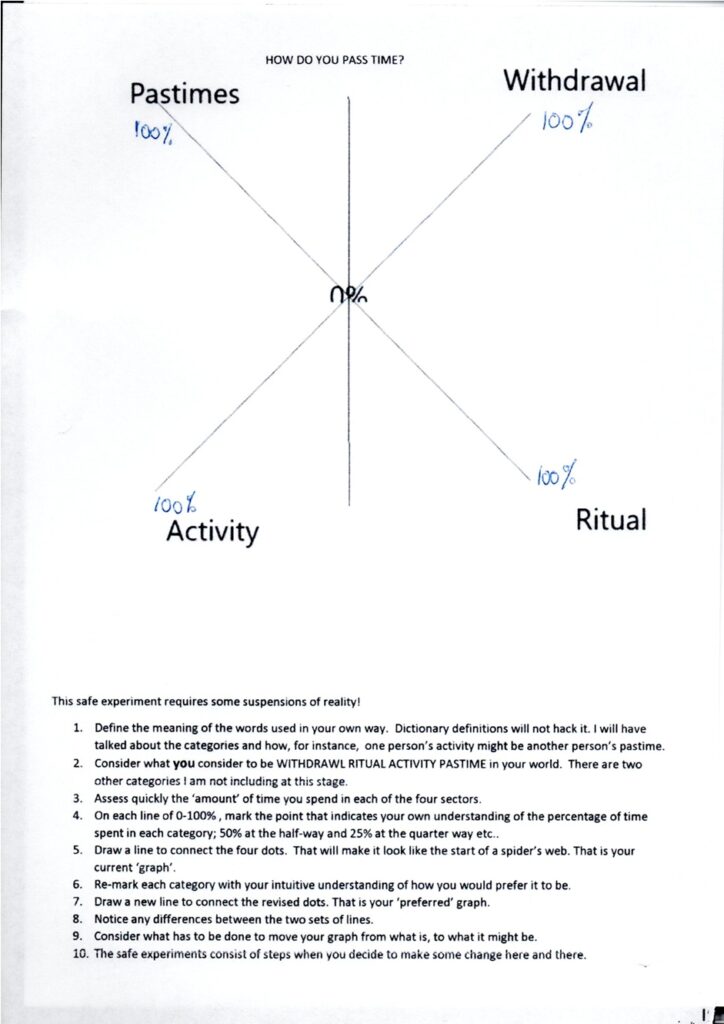
When I do this safe experiment, as summarised, I now choose less ‘activity’, and more time spent ‘pastiming’. Also, I have valued ‘ritual’ more. This routine way of behaving has generated the illusion of predictability that I once obtained from a highly structured ‘working’ life. Gardening is great here; the seasons make their unique, semi-predictable demands.
Finally, I spend more time in ‘withdrawal’, even in the presence of other people. I can appreciate that this decision will not suit each and everyone of us, but it does it for me – if only helping to make me feel more comfortable in my own skin.
The great value of the safe experiment, reviewing my time structure, is that it reminds me to look for more choices. All I have to do is to know what they are so I can choose the ones that are right for me. What I choose will not be what you choose.
A final connection?
This final connection from the website has something to say about the opportunities surrounding me at this stage in my life. The relevant illustration is:
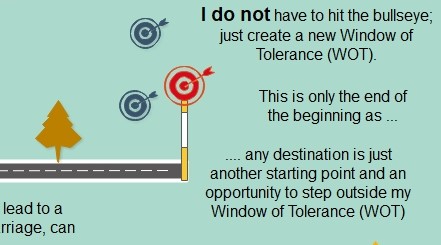
There are many people who think death opens another Window of Tolerance, and other possibilities still exist. For me, it remains an end of the end but what I now know is how I close in on one that remaining destination is the key.
My illustration, above, helps me not to close off other possibilities quite so quickly as I have done. How I close in on that final path is more important than I had realised. There are still ‘paths’ to follow and my view on death does not require me to rush towards nothingness.
True, my Window of Tolerance (WOT) remains narrowed, rather than widened – possibly for the first time in a good few decades. I am closing down more things than I open up but let’s not be too hasty! There may be something else to open up at this late stage. I want to look around a bit more than I have done – without needing a ‘bucket list’ to do that.
This page is unusual as I have chosen not to include a list of leads you might want to follow. By now, you do not need me to help with that process.
Instead, I’ll end with a picture that helps me to say it all:
